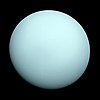Cupid (moon)
| Discovery | |||||||
|---|---|---|---|---|---|---|---|
| Discovered by | Mark R. Showalter and Jack J. Lissauer | ||||||
| Discovered in | August 25, 2003 | ||||||
| Orbital characteristics | |||||||
| Semi-major axis | 74,392 km | ||||||
| Eccentricity | 0.0013 | ||||||
| Orbital period | 0.618 d | ||||||
| Inclination | 0.1° (to Uranus' equator) | ||||||
| Is a moon of | Uranus | ||||||
| Physical characteristics | |||||||
| Mean diameter | ~18 km[1] (estimate) | ||||||
| Surface area | ~1,000 km2 (estimate) | ||||||
| Volume | ~3,000 km3 (estimate) | ||||||
| Mass | ~3.8×1015 kg (estimate) | ||||||
| Mean density | ~1.3 g/cm3 (estimate) | ||||||
| Surface gravity | ~0.0031 m/s2 (estimate) | ||||||
| Escape velocity | ~0.0076 km/s (estimate) | ||||||
| Rotation period | synchronous (assumed) | ||||||
| Axial tilt | zero (assumed) | ||||||
| Albedo | 0.07 (assumed) | ||||||
| Surface temp. |
| ||||||
| Atmospheric pressure | 0 kPa | ||||||
Cupid is an inner moon (which makes it one of the closer moons) of Uranus. It was found by Mark Showalter and Jack J. Lissauer in 2003 using the Hubble Space Telescope.[2] It was named after a character in William Shakespeare's play Timon of Athens.[3]
It is the smallest of the closer Uranian moons, estimated to be only about 18 km in diameter. This and the dark surface made it too dim to be detected by the Voyager 2 cameras during its Uranus flyby in 1986.
The orbit of Cupid is only 863 km from the orbit of the bigger moon Belinda. Amazingly, compared to Mab and Perdita, the recently found Uranian moons, it does not seem to be perturbed.[1]
Following its discovery, Cupid was given the designation S/2003 U 2.[2] It is also designated Uranus XXVII.[3]
It should not be confused with the asteroid 763 Cupido.
References[change | change source]
- ↑ 1.0 1.1 Showalter, Mark R.; Lissauer, Jack J. (2005-12-22). "The Second Ring-Moon System of Uranus: Discovery and Dynamics". Science Express. 311 (5763): 973–977. doi:10.1126/science.1122882. PMID 16373533. S2CID 13240973.
- ↑ 2.0 2.1 Showalter, M. R.; Lissauer, J.J. (September 25, 2003). "IAU Circular No. 8209". Retrieved 2006-08-05.
- ↑ 3.0 3.1 "Planet and Satellite Names and Discoverers". Gazetteer of Planetary Nomenclature. USGS Astrogeology. July 21, 2006. Retrieved 2006-08-05.
Other websites[change | change source]
- Hubble Uncovers Smallest Moons Yet Seen Around Uranus – Hubble Space Telescope news release (2003-09-25)

